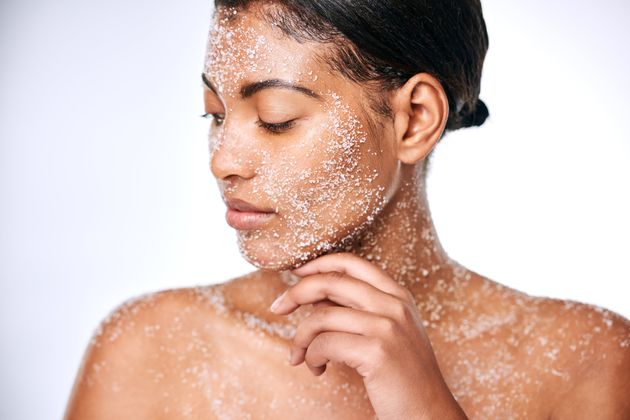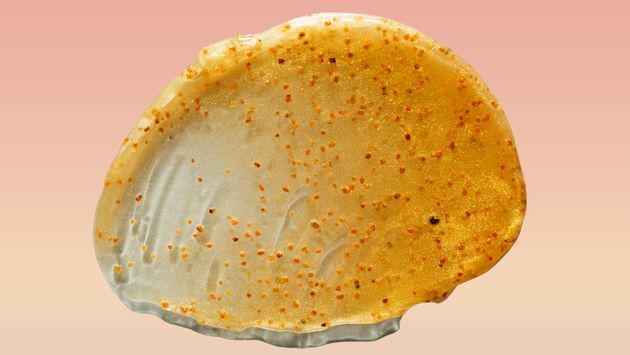These days, it seems everyone says it’s a bad idea to exfoliate your face with a physical exfoliator — St. Ives Apricot Scrub is particularly maligned after receiving years of negative media attention. (Vox has even published a timeline called “St. Ives Apricot Scrub: A Brief History of Hate.”)
But before all that happened, I had no clue I should have a reason to be wary of it.
When I was in college, I washed my face with St. Ives Apricot Scrub twice a day, every day. I loved the fruity scent and how clean and tight it made my skin feel. After a while, though, I noticed my skin looking a little red but I didn’t link it to my skin care habits until I visited a makeup counter at the mall seeking a good concealer to disguise the redness.
“Why are you so red?” the lady behind the counter asked. “What are you using on your skin?” When I told her, she suggested the scrub was too harsh (even St. Ives suggests using the scrub only three to four times a week). She recommended using a gentler cleanser, and I took her advice and noticed an improvement.
But in today’s modern age of advanced dermatology, are we still nixing the St. Ives scrub? We asked dermatologists to weigh in.
The alleged problem with physical exfoliators
While exfoliating does help remove dead skin cells and potentially improve the appearance of your skin, the American Academy of Dermatology says it can cause more harm than good if you exfoliate too much and don’t do it properly.
“It’s tempting to physically scrub our skin to get the fresh clean sensation, but most people tend to overdo it,” Jinmeng Zhang, a board-certified dermatologist at U.S. Dermatology Partners in Peoria, Arizona, told HuffPost.
Physical scrubs include products that contain microbeads or feel gritty, or tools like brushes that enable “mechanical exfoliation,” the AAD says. This exfoliation method usually isn’t gentle enough on your skin and can cause a host of problems, like irritation and redness, Zhang said.
Still, you likely want to exfoliate. Dermatologists explain what you should know about using a physical scrub and why chemical exfoliants, such as alpha and beta hydroxy acids, tend to be a more effective option.
The benefits of exfoliating your skin
Exfoliating itself isn’t what’s bad — it’s how you do it.
Exfoliating removes dead skin cells on the outer layer of your skin. It can smooth, brighten and firm, explained Dr. Howard Sobel, a cosmetic dermatologist and surgeon in New York City. But if you exfoliate too frequently or use a method that’s too abrasive, it can make your skin red and irritated and worsen problems like acne.
 Rough physical exfoliation can cause a host of problems, like irritation and redness.
Rough physical exfoliation can cause a host of problems, like irritation and redness.There are two main ways to exfoliate your face and body: mechanical and chemical, according to AAD. Mechanical exfoliation involves using brushes, sponges or gritty scrubs. Chemical exfoliators include serums, peels or other products that contain substances like glycolic, salicylic and other acids that dissolve dead skin cells more gently.
“I tell patients to avoid using scrubs with large particles to avoid causing any negative reaction such as irritation, redness or flakiness,” Sobel said.
He also said to avoid exfoliating right before spending time in the sun. When you strip the outer layer of skin, it can leave it extra vulnerable to the sun’s harmful rays. (And of course, be sure to wear sunscreen any time you’re out in the sun.)
Avoid exfoliating skin that’s sunburned or has cuts, bug bites, or other wounds, according to the AAD.
If you’re not sure about the best way to exfoliate, Zhang suggested seeing a dermatologist who can help you develop a personalised skin care regimen.
Should you ever physically scrub your skin?
Physical scrubs can temporarily remove oil, dirt and dead skin cells, as well as thin out thicker areas of the skin such as on your heels, Zhang said.
But she generally doesn’t recommend them. The abrasiveness of physical or mechanical scrubs can cause irritation, dryness and rashes, especially if you have sensitive skin or conditions like eczema.
However, when dead skin cells accumulate, they can clog pores and cause whiteheads and blackheads, Sobel said. So if your skin is acne-prone or oily, you might benefit from physical exfoliating a couple of times a week if it doesn’t cause irritation — but no more.
“I would advise people to use gentle sponges and washcloths, rather than a physical scrub,” Zhang said. “I find that products with beads or small granules and brushes are too abrasive.”
If you do choose a physical scrub, the AAD suggests using small gentle circular motions to avoid damaging the skin.
Why chemical exfoliants are a more effective option
Chemical exfoliation is generally better tolerated by most people, but especially if you have normal or dry skin, Zhang said. “It has less potential to cause micro-traumas compared to physical scrubs.”
Look for products like serums, toners or body lotions that contain alpha hydroxy acid (AHA) such as glycolic, lactic or citric acid. You can also look for beta hydroxy acid (BHA) like salicylic acid, Sobel said. These substances can remove dead skin cells, unclog pores and improve skin texture without being abrasive.
These acids can also help minimise the appearance of fine lines, wrinkles, age spots, hyperpigmentation and large pores, according to the Cleveland Clinic. Products contain different concentrations of AHAs and BHAs, so if you’re new to them, start with items with 10% to 15%.
Most people can tolerate using a chemical exfoliator a couple of times a week, Zhang said. With so many products out there, she added that you may need to experiment with different AHAs or BHAs to find one that works best for you.
Another option is a prescription-strength retinoid, like tretinoin, which a dermatologist can provide, Zhang said. It exfoliates and promotes anti-aging, including improving fine lines, discolouration and overall skin appearance.
Keep in mind that exfoliating, even chemically, can sometimes dry out the skin, which is why dermatologists recommend only doing it a few times a week. The AAD says to moisturise after you exfoliate to keep your skin hydrated.






